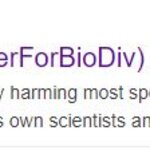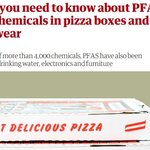Chemistry

In 2002, Berkeley Professor Tyrone Hayes got a paper titled "Hermaphroditic, demasculinized frogs after exposure to the herbicide atrazine at low ecologically relevant doses" published in Proceedings of the National Academies of Science.
In it, he claimed this common herbicide was changing the sexuality of frogs, an indicator species.
Though it was less than 20 years ago, it might as well have been a lifetime. PNAS published the paper, but it turned out to have been hand-walked past peer review by a member of the NAS, using a courtesy policy PNAS changed only after I revealed it in a Wall…

A few years ago I sent an employee to a debate to argue over what was more harmful for your body, the pizza or the pizza box.
I am not kidding. A subset of activists absolutely says with straight faces that a trace chemical in a box is more harmful than getting fat. And now they have gotten Democrats in Congress to demonize over 6,000 forms of PFAS and open up nearly every company in America to lawsuits.
In reliable anti-science outlets like Guardian in the UK, whole sponsored sections of their publication are devoted to promoting claims by all kinds of groups. You can get published there if…

Some people can experience a rash or sensitivity to some cosmetics while most people are fine. It isn't that modern cosmetics are bad, regardless what alternative companies and their trade groups like Campaign for Safe Cosmetics claim, it's nature. Botanical extracts sold as "natural" chemicals in cosmetics cause the same issue.
Poison ivy is a commonly known trigger for allergic contact dermatitis, an itchy skin rash, and everyone can agree that is natural. Some ingredients in nonprescription topical products, both conventional and labeled "organic" or "natural" can trigger a similar type of…

Many people are reluctant to use sunscreen, even though it’s an important element in preventing the skin cancers that affect about two in three of us at some time in our lives.
The Cancer Council says myths about sunscreens contribute to this reluctance. Here are 4½ sunscreen myths and what the evidence really says. Confused about the ½? Well, it’s a myth most of the time, but sometimes it’s true.
Myth #1. Its ingredients are toxic
If you google “toxic sunscreen”, you get more than eight million results. So people are clearly worried if it’s safe.
However, there’s little evidence of harm…

Formaldehyde is one of the most studied,
and regulated, chemical substances in commerce today. For decades, this
substance has been continuously studied to help ensure regulated safe exposure
levels for formaldehyde are protective.
Formaldehyde is almost exclusively used as a chemical
intermediate, meaning it is manufactured and then converted into another
chemical in subsequent steps to ultimately generate the final product. This
means little (if any) formaldehyde remains in the final products that consumers
use.
Because of formaldehyde's unique physical and chemical
properties, few…

In March of 1869, the chemist Dmitri Ivanovich Mendeleev made a presentation to the Russian Chemical Society and outlined patterns in elements that led him to postulate his periodic table of the existing 63 elements. Since a new one was being discovered about once per year, he also made sure to leave room for additions and even hypothesized a few more.
Chemistry was the future, understanding elements was key, he and others believed, and they turned out to be right. If you are reading this article on a cell phone, notes New York University, you're holding at least 30 different…

Let's say your Generation Z child is concerned about chemicals in your Thanksgiving meal and you want to avoid that awkward moment when they don't look up from their phones while saying "OK Boomer" as you try to explain to them that all food has chemicals.
Maybe they just don't want scientific chemicals. Maybe they want the organic kind that are healthier, according to, well, organic industry trade groups and journalists at the Mother Jones company.
So you trudge off to Whole Foods or a store you read about on a Facebook page and buy the stuff on your menu, all certified expensive. I hate to…

Scientists have written a paper talking about how they "rediscovered" a pesticide that had never really been forgotten but had been ignored because it was created during the Nazi regime and really expensive; DFDT, a chemical relative of DDT. German scientists called it "Fluorgesarol"(1) and "Gix." DDT is dichlorodiphenyltrichloroethane and DFDT replaces the chlorine atoms with fluorine so it's difluorodiphenyltrichloroethane.(2)
In the latter half of World War II, the Germans were desperate to stop the Allied invasion to take back Europe. The first theater wasn't Normandy in June of 1944, it…

The organic food industry, even large players like Whole Foods, created a disturbing trend; lying to customers about whether or not organic food uses pesticides or chemicals.
In reality, organic food is covered in pesticides. If they were not, instead of only being an average of 13 percent more expensive than regular food (thanks to Amazon squeezing efficiency, it was 20 percent and higher when Whole Foods was a separate company) it would be 80 percent. Pests and other natural blights would devastate their crops.
This is why organic trade groups have resisted calls to put one thing on labels…

Placebo controls are a gold standard against which new treatments are often measured. If a new treatment consistently proves to be better than a placebo and safe, it can be marketed, sold and prescribed. Otherwise, it can’t – or at least shouldn’t. The problem is that, as our latest study reveals, researchers don’t report what placebos contain. Different placebos have different effects, and the choice of what’s in a placebo can lead to mistaken inferences about a new treatment’s benefits or harms.
Here are a few examples. Olive oil was previously used as a placebo control for cholesterol-…